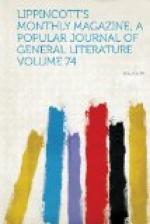Among the commonalty of Britain, within a very few years past, rifle-clubs and matches have been brought greatly into vogue under government encouragement. Austria, tu infelix this time, having served unwillingly as an experimental target, with the most distinguished and gratifying success to the experimenters, at Solferino and Sadowa, gave a new impetus to the rifle movement in England, as France, a trifle later, did to the Battle-of-Dorking school of prophetic literature. Thus it happens that the rifle is taking its place gradually by the side of fat Durhams, gooseberries, lop eared rabbits and the Derby as a popular sensation. Johnny sends over a “team,” evidently in his judgment a whole one, to “shoot the American continent.” His next deputation ought to be sent, after vanquishing the “blarsted” Gothamites, to the recesses of the Alleghany, and pitted there against the woodsman with his ancient weapon carrying a round ball of seventy-five to the pound, five feet long and decorated with tin sights, double trigger and mayhap flint-lock. The adventurers would beat in the long run, but they would go home not wholly unlearned. Should they stay to a turkey-shoot, they would see in it the Occidental analogue of their own public matches—more picturesque, if not quite so prim and scientific. Strictly, it presupposes conditions non-existent in England—a community, for instance, first of hunters, and second of hunters with the rifle.
This recreation, primarily belonging to localities where large game, such as deer and wild-turkeys, is found, has spread down to the cities, where it breaks out in a sporadic form about Christmas. But the hills are its home—the foot-hills, notably, of the Appalachian range, the domestic turkey not being very common higher up, nor its wild original ("original,” we insist, pace the Agricultural Report ornithologist, who finds an ineffaceable distinction in the fact that the tail-ring of the one is sometimes, and that of the other never, white!) lower down.
We mind us of an ancient town in the Valley of Virginia, settled nearly a century and a half ago by riflemen, sheltered by them through a stormy infancy, and still steeped in the traditions of the implement in question. Spitted by the railway, the hub of many turnpikes, and surrounded by a thickly-peopled country, it is yet near enough to the mountains to receive from them each winter quite a delegation of their inhabitants. Last year wild-turkeys were shot within the corporate limits, a deer was chased within half a mile of them, and a fine specimen of Felis Canadensis was killed in an orchard still nearer.




